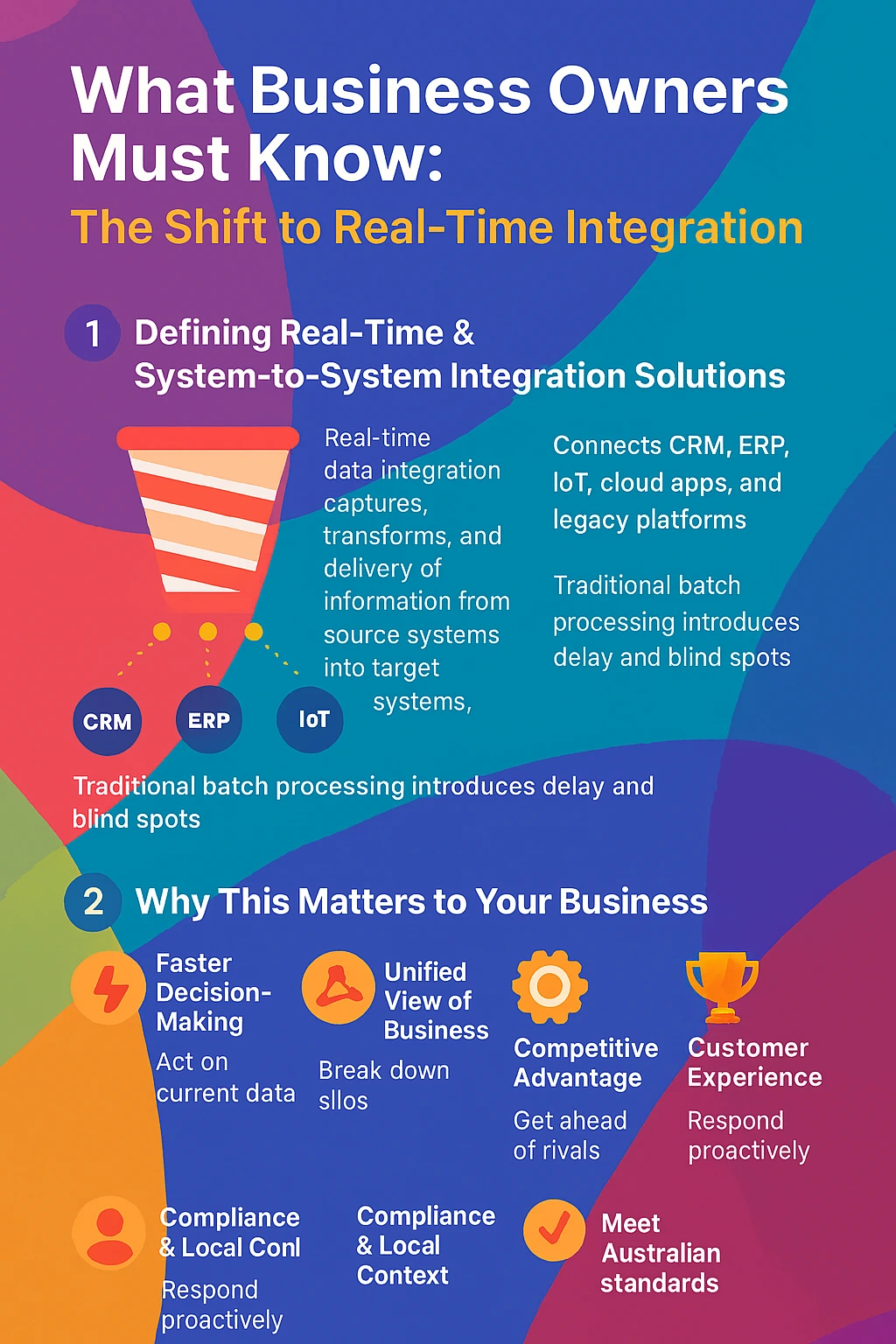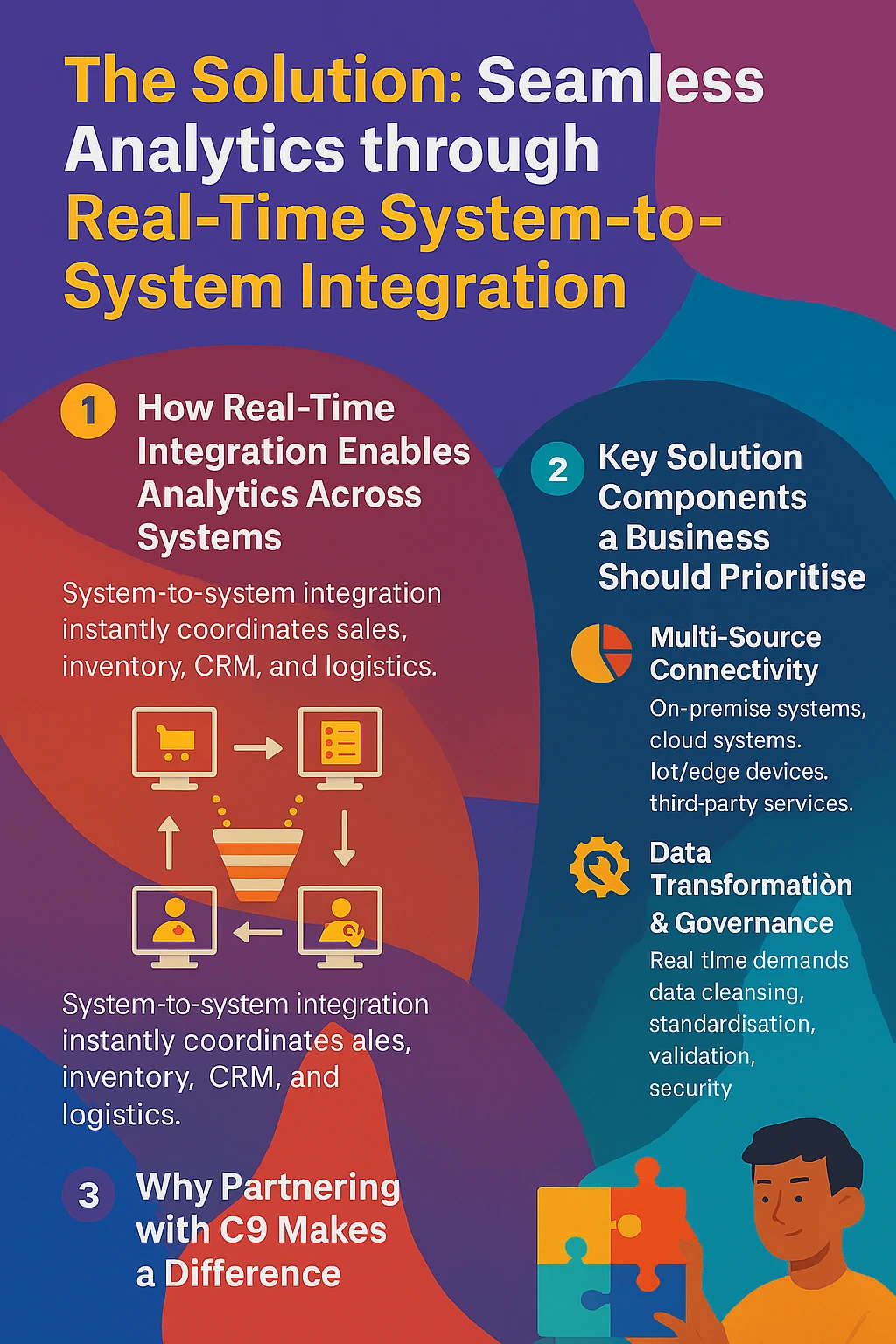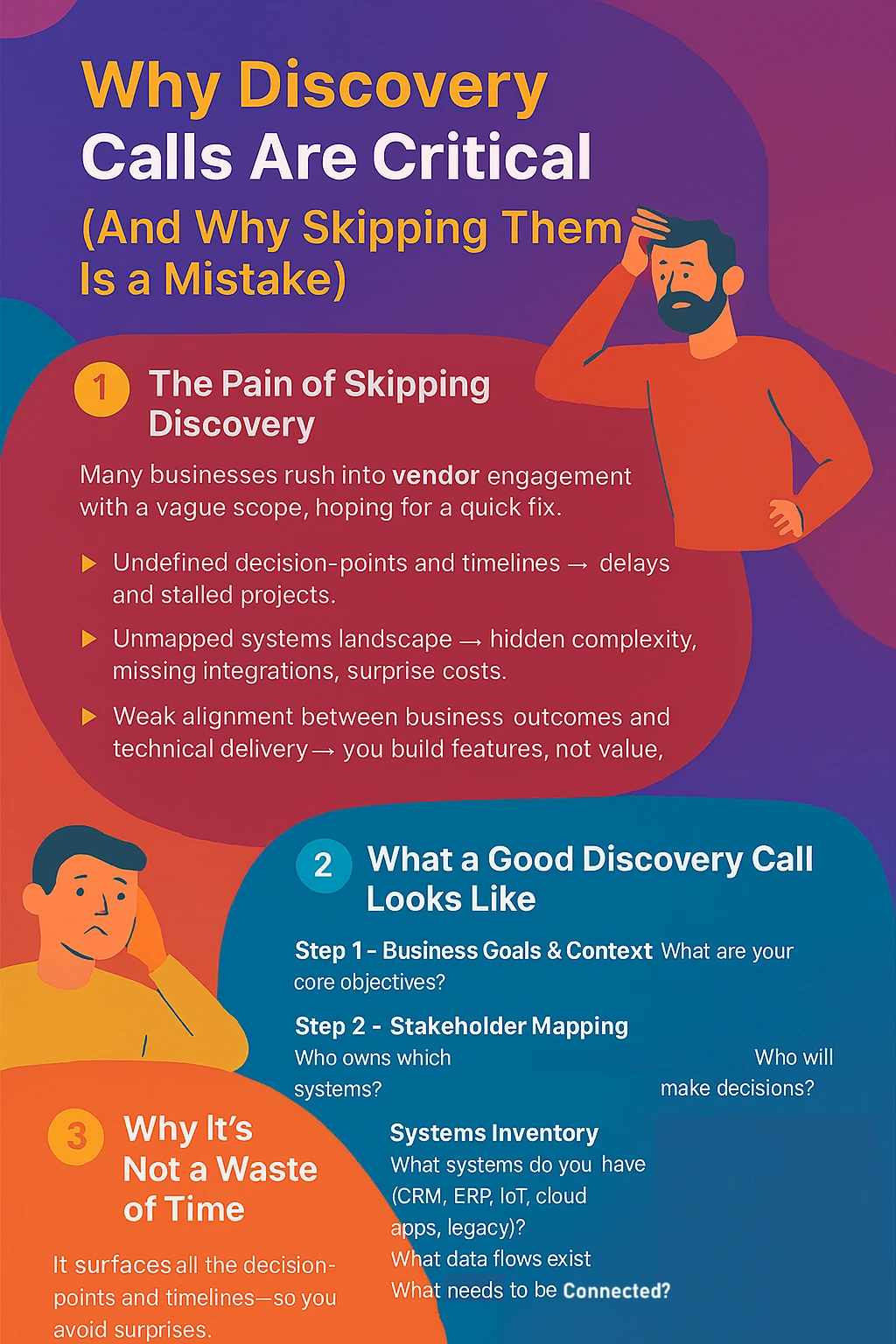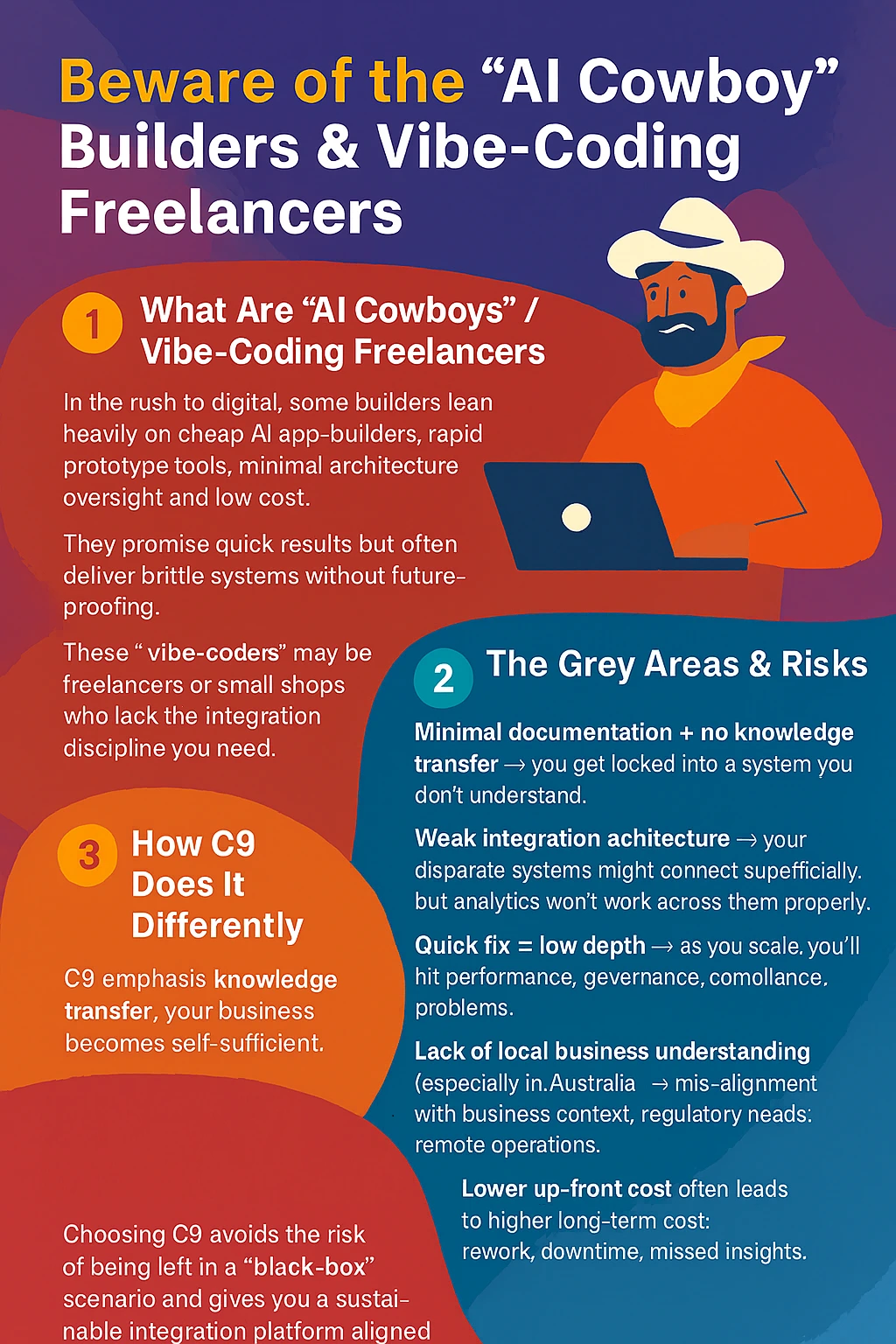In the fast-moving Australian business environment, executives are increasingly caught between two forces: the need to respond quickly to market shifts, and the reality of outdated, siloed systems. If you run a company where customer data sits in a CRM, sales data in an ERP, field operations in a separate legacy system—and none of them “talk” to each other—you’re operating with blind spots. Decisions are delayed, insights are stale, and precious opportunities slip away.
This is where system-to-system integration solutions step in. When your disparate systems are connected, when data flows in real time, and when analytics span across all of your business systems, you unlock the ability to act with speed and clarity. In this blog, we’ll walk you through exactly what business owners and executives in Australia must know about real-time integration, show you why skipping a proper discovery is a mistake, highlight how to avoid cheap “vibe-coding” approaches, and explain how to structure your engagement for success. Most importantly, we’ll explain why C9, as Australia’s leading custom software, apps, integration & database developer, is the partner to trust.
What Business Owners Must Know: The Shift to Real-Time Integration

1 Defining Real-Time & System-to-System Integration Solutions
Real-time data integration refers to the ongoing, low-latency capture, transformation and delivery of information from source systems into target systems, enabling analysis and action almost instantly.
When we speak of system-to-system integration solutions, we mean connecting multiple systems—CRM, ERP, IoT/edge devices, cloud apps, legacy platforms—so they exchange data and analytics can span across them.
Contrast this with traditional batch processing, where data is collected, transformed and loaded at scheduled intervals (daily, hourly). That model introduces latency and blind spots. Real-time integration removes much of that delay.
2 Why This Matters to Your Business
-
Faster Decision-Making: With real-time data, you no longer wait for yesterday’s numbers. You act on what’s happening now.
-
Unified View of Business: When systems are integrated, you break down silos and gain a 360° view of customers, operations and performance.
-
Operational Efficiency: Real-time integration reduces manual reconciliation, redundant data entry, and error-prone hand-offs.
-
Competitive Advantage: Australian businesses that manage to integrate quickly are positioned ahead of those still working in disconnected islands.
-
Customer Experience: With connected operations, you can respond faster to customer behaviour, personalise offers, optimise inventory, service proactively.
-
Compliance & Local Context: In Australia, data sovereignty, regulatory frameworks, remote operations (e.g., mining, logistics) add layers of complexity — which means real-time system-to-system integration is especially valuable.
3 The Pain of Getting It Wrong
-
Legacy systems that aren’t designed for streaming or real-time integration create bottlenecks.
-
Poor data quality: When you integrate in real time without robust cleansing and governance, you risk feeding analytics garbage.
-
Scope creep and cost overruns: Many integration projects start without proper planning, leading to delays, budget blow-outs, unmet expectations.
-
Analytics across systems only works if the foundations are right: integration alone isn’t enough if you haven’t aligned on what decisions you want to make.
-
Business disruption: If you implement poorly, you may disrupt operations rather than enhance them.
The Solution: Seamless Analytics through Real-Time System-to-System Integration

1 How Real-Time Integration Enables Analytics Across Systems
Imagine you are a retail business. You integrate your point-of-sale system, your inventory management, your CRM, and maybe your logistics/tracking. With real-time integration:
-
Sale event occurs → immediately recorded in CRM, inventory is updated, logistics notified.
-
Analytics platform sees real-time stock levels + customer purchase behaviour + field service data → triggers dynamic pricing, replenishment alerts, personalised offers.
This is the power of system-to-system integration solutions delivering real-time data for analytics.
2 Key Solution Components a Business Should Prioritise
When you evaluate a real-time system integration project, focus on:
-
Multi-Source Connectivity: On-premise systems, cloud systems, IoT/edge devices, third-party services.
-
Streaming / Low-Latency Pipelines: Event-based ingestion, change data capture, continuous flow, not just batch.
-
Data Transformation & Governance: Real-time demands data cleansing, standardisation, validation, security.
-
Analytics Layer & Dashboards: You must deliver useful insights to business users, not just move data.
-
Operational Monitoring & Scalability: Real-time systems are live systems. They require monitoring, error handling, scalability.
-
Phased Delivery / ROI-Focus: Don’t attempt full roll-out in one go. Aim for an MVP, early value, then scale.
3 Why Partnering with C9 Makes a Difference
Here is why C9 stands out for system-to-system integration solutions:
-
With deep Australian business experience, C9 understands your needs, the local regulatory environment, and the scale of integration across sectors.
-
They are not simply app-builders — they specialise in integration & automation: APIs, service-bus, enterprise application integration.
-
Their hybrid in-house/offshore model means you get cost-efficient access to global talent combined with local accountability.
-
They emphasise knowledge transfer — so your team is empowered, not left dependent on one freelancer or black-box code.
-
They offer staff-augmentation and full-team engagement (teams of developers, testers, integration specialists) rather than a lone developer.
-
Flexible contracting, scalable monthly packages, roll-over hours, long-term engagement discounts — aligned to your business, not just the tech.
-
They deliver for FY25/26 rates that reflect skill-sets and blended on-shore/off-shore talent — giving you value over inflated hourly local rates.
Why Discovery Calls Are Critical (And Why Skipping Them Is a Mistake)

1 The Pain of Skipping Discovery
Many businesses rush into vendor engagements with a vague scope, hoping for a quick fix. But skipping the structured discovery leads to:
-
Undefined decision-points and timelines → delays and stalled projects.
-
Unmapped systems landscape → hidden complexity, missing integrations, surprise costs.
-
Weak alignment between business outcomes and technical delivery → you build features, not value.
-
Indicative pricing based on guesswork → budget blow-outs or inferior solutions.
2 What a Good Discovery Call Looks Like
-
Step 1 – Business Goals & Context: What are your core objectives? What decisions do you need to make faster?
-
Step 2 – Stakeholder Mapping: Who owns which systems? Who will make decisions? What is the timeline?
-
Step 3 – Systems Inventory: What systems do you have (CRM, ERP, IoT, cloud apps, legacy)? What data flows exist? What needs to be connected?
-
Step 4 – Analytics & KPI Definition: What outcomes matter? What level of latency is acceptable? What does “success” look like?
-
Step 5 – Timeline & Phasing: When do you want your first ROI? What is phase 1 vs full roll-out?
-
Step 6 – Governance, Security, Compliance: Essential for Australian business context.
-
Step 7 – Engagement Model & Costing: Staff augmentation, hybrid teams, minimum term contracts.
-
Step 8 – Next Steps & Deliverables: Agree on deliverables, scope document, quote, timeline.
3 Why It’s Not a Waste of Time
-
It surfaces all the decision-points and timelines—so you avoid surprises.
-
It produces a clear scope and cost estimate based on actual system-to-system integration complexity.
-
It aligns business and technical stakeholders—so delivery supports business outcomes.
-
It allows early-phase delivery (MVP) and scales later—so you begin realising value sooner.
-
For a provider like C9, it ensures you get the right team, the right contract model, the right governance from day one.
Beware of the “AI Cowboy” Builders & Vibe-Coding Freelancers

1 What Are “AI Cowboys” / Vibe-Coding Freelancers
In the rush to digital, some builders lean heavily on cheap AI app-builders, rapid prototype tools, minimal architecture oversight and low cost. They promise quick results, but often deliver brittle systems without future-proofing.
These “vibe-coders” may be freelancers or small shops who lack the integration discipline you need.
2 The Grey Areas & Risks
-
Minimal documentation + no knowledge transfer → you get locked into a system you don’t understand.
-
Weak integration architecture → your disparate systems might connect superficially, but analytics won’t work across them properly.
-
Quick fix = low depth → as you scale, you’ll hit performance, governance, compliance problems.
-
Lack of local business understanding (especially in Australia) → mis-alignment with business context, regulatory needs, remote operations.
-
Lower up-front cost often leads to higher long-term cost: rework, downtime, missed insights.
3 How C9 Does It Differently
-
C9 emphasises knowledge transfer: your business becomes self-sufficient.
-
C9 uses proper architecture, governance, integration discipline—not just “plug and go” tools.
-
C9 offers a full team, not a single freelancer: developers, integration specialists, testers, analytics experts.
-
C9’s hybrid offshore/in-house model gives you cost-efficiency and quality assurance.
-
Choosing C9 avoids the risk of being left in a “black-box” scenario and gives you a sustainable integration platform aligned with your business goals.
Staff Augmentation Options & Flexibility

1 What Staff Augmentation Means
Staff augmentation means you bolster your team by engaging C9’s resources for your integration project, rather than hiring full-time local staff.
For system-to-system integration solutions, this approach gives you specialist skills, flexible capacity, and experienced teams aligned with your business timeline.
2 Flexibility of Engagement Models
-
Month-to-month with minimal lock-in: Scalable, flexible, useful when workload is variable.
-
Minimum lock-in of 3–6 months: Why this is better for integration: onboarding takes time, systems ramp-up, knowledge transfers. A 3–6 month minimum provides continuity and better value.
-
After the initial lock-in you may move to month-to-month, scale up/down, roll-over hours for feature development.
3 What Makes C9’s Approach Different
-
C9’s team is remote/hybrid — not constrained to “someone in your office 9-5”. That means you pay for outcomes, not just desk hours.
-
Their rates vary by skill-set and assume a mix of on-shore and offshore C9-hired talent — meaning you save over inflated solo Australian-developer rates.
-
Additional discounts for long-term or multi-resource (>3) engagements.
-
Monthly packages that offer roll-over hours and scalable resources — giving you predictability and flexibility.
-
You don’t get just a single developer: you get an integrated team aligned to your system-to-system integration solution.
4 Top FAQs for Staff Augmentation
-
Q: Will someone sit in our office 9-5 every day?
A: Not necessarily — the model is hybrid/remote, focused on deliverables rather than time-in-desk.
-
Q: Are we locked into one developer?
A: No — you get team coverage and flexibility.
-
Q: Can we change skill-sets mid-term?
A: Yes — C9 allows flexibility to adjust resources.
-
Q: What happens after the 3–6 month lock-in?
A: You can transition to month-to-month, scale down/up, continue as required.
-
Q: How are rates determined and how much savings?
A: Rates are based on skill-set and blended on-shore/off-shore resources, offering savings over traditional purely local rates.
Indicative Pricing & Why It’s Often Misleading
1 The Pitfalls of “Indicative Pricing”
Many vendors provide broad ball-park figures without proper discovery. For example: “We’ll integrate your systems for ~$50 000” without detail. The problems:
-
The pricing may be based on guesses—nearest hour rather than nearest day/weeks.
-
Hidden assumptions: number of systems, latency requirements, legacy complexity not accounted for.
-
You might sign off, but then scope creep, extra hours, unexpected data-flows kick in.
-
Result: budget blow-out, stalled delivery, disappointment.
2 How Discovery-Based Pricing Works
With proper discovery you:
-
Map the systems, data flows, decision-points, timeline.
-
Define phases: Stage 1 (MVP) → Stage 2 (Scale) → Stage 3 (optimisation).
-
Estimate hours by days/weeks for each phase rather than guesswork.
-
Example:
-
Stage 1: integrate 3 core systems + real-time alerting → 300 hours × blended $90/hr = $27,000
-
Stage 2: add 4 systems + advanced analytics dashboard → 400 hours = $36,000
-
Stage 3: optimisation & training → 100 hours = $9,000
-
Total roll-out = $72,000 — but you get early results in Stage 1.
-
With discovery, you compare providers on the same scope and avoid surprises.
3 Why Discovery Is Worth It (Again)
-
You get clarity on what you’re buying, how much it costs, when you’ll see value.
-
You begin early with ROI rather than waiting for a big bang.
-
You align business and technical stakeholders before delivery begins.
-
You minimise risk and increase likelihood that your system-to-system integration solution delivers business value, not just technology.
Why Choose C9 Over Other Developers
-
Since 2007, C9 has been helping Australian businesses with custom software, apps, integrations and databases.
-
Their core strength: system-to-system integration solutions — they connect disparate systems, deliver real-time data flows and give you analytics across systems, not just apps.
-
Their blended hybrid offshore/in-house model gives you cost efficiency and quality assurance — unlike many local solo freelancers or cheap AI-builders.
-
Knowledge transfer is built into their process: you aren’t locked into a black box, your team learns and you build enduring capability.
-
Staff augmentation options and flexible contract models (3–6 month lock-in then month-to-month, roll-over hours, scalable packages) give you control.
-
Transparent rate structure: FY25/26 rates reflect mixed on-shore/off-shore talent; discounts available for long term and multiple resources; savings over inflated single-developer rates.
-
Full team delivery rather than solo developer — you get developers, testers, integration specialists aligned to your project.
-
Local understanding: As an Australian business, C9 understands your regulatory environment, business culture and the complex integration demands in the region.
Conclusion
If you remain with disconnected systems, batch data flows and manual reconciliation, you’ll continue to lag behind. The ability to make decisions in real time—across all of your business systems—is now a strategic imperative. By implementing robust system-to-system integration solutions, you unlock the potential of real-time data, analytics and agile decision-making.
Skipping discovery is a mistake. Without a clear map of your systems, decision-points, timeline and costs, you’re stepping into the unknown. A structured discovery call aligns your business, defines scope, phases your project and positions you for success.
When you partner with C9, you work with a specialist who understands system integration, offers knowledge transfer, provides flexible and cost-effective staffing models, and delivers full-team capability—so you’re not locked into a single developer or short-term fix.
Ready to transform your business with real-time system-to-system integration?
Book your free discovery call with C9 today. Let us help you map your integration journey, align your analytics roadmap and start making smarter business decisions faster.